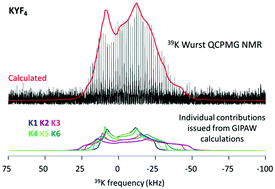Ask for a reprint
email :
* Give your email
2019
ACL
|
J.Dabachi, M.Body, J.Dittmer, A.Rakhmatullin, F.Fayon, C.Legein, 'Insight into the factors influencing NMR parameters in crystalline materials from the KF-YF3 binary system', Dalton Trans. 48 587-601 (2019) doi:10.1039/c8dt03241f
Solid state NMR signals are very sensitive to the local environment of the observed nucleus; however their interpretation is not straightforward. On the other hand, first-principles DFT calculations of NMR parameters can now be applied to periodic compounds to predict NMR parameters. Thus, ab initio calculations can help to interpret NMR spectra exhibited by complex materials, to assign NMR lines to structural environments, and even to enlighten the environmental factors influencing the NMR parameters for a given nucleus. Both techniques have been applied to crystalline compounds of the KF-YF3 binary system, γ-K3YF6, K2YF5, KYF4, β-KY2F7 and α-KY3F10, which present a variety of YFn and KFm polyhedra. First, the structure of K2YF5 was refined in the Pnma space group and, for all compounds, atomic positions were optimized by DFT. 19F, 89Y and 39K NMR spectra have been recorded and the measured NMR parameters are compared to those calculated from first-principles DFT method, allowing unambiguous assignments of NMR lines to crystallographic sites. Linear correlations between experimental δiso and calculated σiso for the three nuclei are used to predict theoretical 19F spectra of KYF4 (24 F sites) and β-KY2F7 (19 F sites) as well as the 39K spectrum of KYF4 (6 K sites). For 89Y and 39K, both computational and experimental results show a decrease of the isotropic chemical shift values when the cation coordination number increases. Above all, 89Y isotropic chemical shift values correlate with the number of K atoms present in the Y second coordination sphere. For 19F, the combination of isotropic chemical shift and chemical shift anisotropy allows to distinguish four kinds of F environments.
|

|